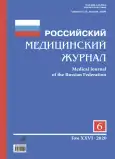Combination of the spinal hernia, sprengel’s deformity, and situs viscerum inversus
- 作者: Ivanov S.V.1, Zharkov D.S.1
-
隶属关系:
- G.I. Turner National Medical Research Center for Сhildren’s Orthopedics and Trauma Surgery
- 期: 卷 26, 编号 6 (2020)
- 页面: 439-445
- 栏目: Case reports
- URL: https://journals.rcsi.science/0869-2106/article/view/65003
- DOI: https://doi.org/10.17816/0869-2106-2020-26-6-439-445
- ID: 65003
如何引用文章
详细
Background. The combination of Sprengel’s deformity with various types of spinal hernias and internal organ development anomalies, such as situs viscerum inversus (inverse or mirror location of internal organs), is a rare case. The etiology of these malformations is unknown, but their combination may suggest a common pathogenesis and cause.
The work aimed to review the literature and describe a clinical case of a patient with multiple malformations of the spine and spinal cord along with unilateral Sprengel’s deformity and situs viscerum inversus.
Materials and methods. A 4-year-old patient was diagnosed with myelomeningoradiculocele of the lumbosacral spine, malformation of the spine by the segmentation impairment type of C7–Th1, Th1–Th2, and Th2–Th3 vertebrae, non-closure of the arches of the С5–Т2 and Т12–S5 vertebrae, S-shaped congenital scoliosis, condition after surgical removal of myelomeningocele of the lumbosacral spine, concrescence and hypoplasia of ribs 1, 2, and 3 on the right, severe right-sided Sprengel’s deformity, and situs viscerum inversus.
Conclusions. The case description of concomitant malformations contributes to clinical material accumulation and further research in determining the factors of etiopathogenesis. Understanding the processes of pathoembryogenesis in combined malformations of the musculoskeletal system allows early suspicion and identification of latent deformities.
作者简介
Stanislav Ivanov
G.I. Turner National Medical Research Center for Сhildren’s Orthopedics and Trauma Surgery
编辑信件的主要联系方式.
Email: ortostas@mail.ru
ORCID iD: 0000-0002-2187-3973
Candidate of Medical Sciences, Head of Department Nо. 5 (Department of Cerebral palsy
and Center Spina Bifida), G.I. Turner National Medical Research Center for Сhildren's Orthopedics and Trauma Surgery
Dmitry Zharkov
G.I. Turner National Medical Research Center for Сhildren’s Orthopedics and Trauma Surgery
Email: zds05@mail.ru
ORCID iD: 0000-0002-8027-1593
俄罗斯联邦, 196603, Saint-Petersburg, Pushkin, Russian Federation
参考
- Baindurashvili AG, Ivanov SV, Kenis VM. Clinical implications of the neurosegmental level of injury in the treatment of hip dislocation and subluxation in children with spina bifida. Pediatric Traumatology, Orthopaedics and Reconstructive Surgery. 2016;4(4):6–11. (In Russ). doi: 10.17816/ptors446-11.
- Elikbaev GM, Khachatryan VA, Karabekov AK. Congenital spinal pathology in children: a training manual. Shymkent; 2008. 80 p. (In Russ).
- Liptak GS, Samra EA. Optimizing health care for children with spina bifida. Dev Disabil Res Rev. 2010;16(1):66–75. doi: 10.1002/ddrr.91.
- van Aalst J, Vles JS, Cuppen I, et al. Sprengel’s deformity and spinal dysraphism: connecting the shoulder and the spine. Childs Nerv Syst. 2013;29(7):1051–1058. doi: 10.1007/s00381-013-2057-0.
- Ozek MM, Cinalli G, Maixner WJ. The Spina Bifida Management and Outcome. Milan: Springer; 2008.
- Pozdeev AA. Operative treatment of severe forms of congenital elevation of scapula in children. Vestnik Khirurgii im. I.I.Grekova. 2006;165(1):56–61. (In Russ).
- Piegger J, Gruber H, Fritsch H. Case report: human neonatus with spina bifida, clubfoot, situs inversus totalis and cerebral deformities: sequence or accident? Ann Anat. 2000;182(6):577–581. doi: 10.1016/S0940-9602(00)80108-9.
- Copp AJ, Greene ND. Genetics and development of neural tube defects. J Pathol. 2010;220(2):217–230. doi: 10.1002/path.2643.
- Young M, Selleri L, Capellini TD. Genetics of scapula and pelvis development: an evolutionary perspective. Curr Top Dev Biol. 2019; 132:311–349. doi: 10.1016/bs.ctdb.2018.12.007.
- Giacoia GP, Say B. Spondylocostal dysplasia and neural tube defects. J Med Genet. 1991;28(1):51–53. doi: 10.1136/jmg.28.1.51.
- Vijayan S, Shah H. Spondylocostaldysostosis with Sprengel's shoulder – report of a new association with Jarcho–Levin syndrome. Kerala J Orthop. 2012;25:103–104.
- Banniza von Bazan U. The association between congenital elevation of the scapula and diastematomyelia: a preliminary report. J Bone Joint Surg Br. 1979;61(1):59–63. doi: 10.1302/0301-620X.61B1.422634.
- Jeannopoulos CL. Congenital elevation of the scapula. J Bone Joint Surg Am. 1952;34A(4):883–892.
- Mittal N, Majumdar R, Chauhan S, Acharjya M. Sprengel’s deformity: association with musculoskeletal dysfunctions and tethered cord syndrome. BMJ Case Rep. 2013;2013:bcr2013009182. doi: 10.1136/bcr-2013-009182.
- Eulenberg М. Hochgradige discolation der scapula. Archiv fur Klinische Chirurgie. 1863;4:304–311. (In German).
- Sprengel O. Die angeborene Verschiebung des Schulterblattesnachoben // Archiv fur Klinische Chirurgie von Langenbeck. 1891. Vol. 42. P. 545–549. (In German).
- Tulp N. Observationum Medicarum. Libri Tres. Cum aeneis figuris. Amsterdam: Elzevirivs; 1641. (In German).
- Severinus MA. De Recondita abscessum natura. Neapoli: Beltranum; 1632. (In Italian).
- Morgagni JB. De sedibus, et causis morborum per anatomen indagatis libri quinque. Venice: Typographia Remondiniana; 1761.
- Virchow R. Ein fall von hypertrichosis circumscripta mediana, kombiniert mit spina bifida occulta. Ztschr f Ethnol. 1875;7:280–290. (In German).
- Chiari H. Über Veränderungen des Kleinhirns, des Pons und Medulla oblongata infolge von kongenitaler Hydrocephalie des Grosshirns. Denkschriften der Kais Akad Wiss math-naturw. 1896;63:71–116. (In German).
- Kozma C. Skeletal dysplasia in ancient Egypt. Am J Med Genet A. 2008;146A(23):3104–3112. doi: 10.1002/ajmg.a.32501.
- Horwitz AE. Congenital elevation of the scapula-Sprengel's deformity. Am J Orthop Surg. 1908;6:260–311.
- Cavendish ME. Congenital elevation of the scapula. J Bone Joint Surg Br. 1972;54(3):395–408.
- Farsetti P, Weinstein SL, Caterini R, et al. Sprengel's deformity: long-term follow-up study of 22cases. J Pediatr Orthop B. 2003;12(3):202–210. doi: 10.1097/01.bpb.0000049568.52224.1e.
补充文件









